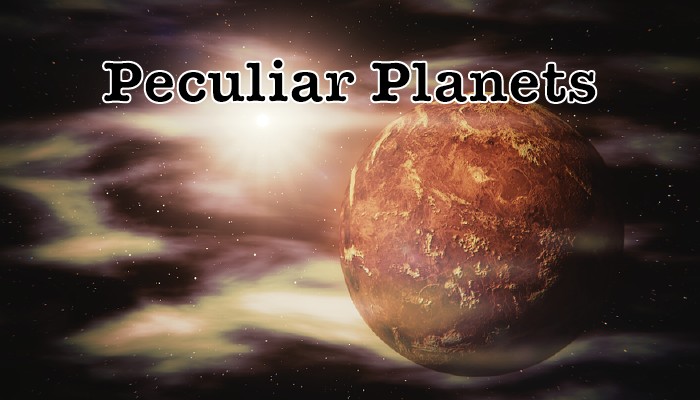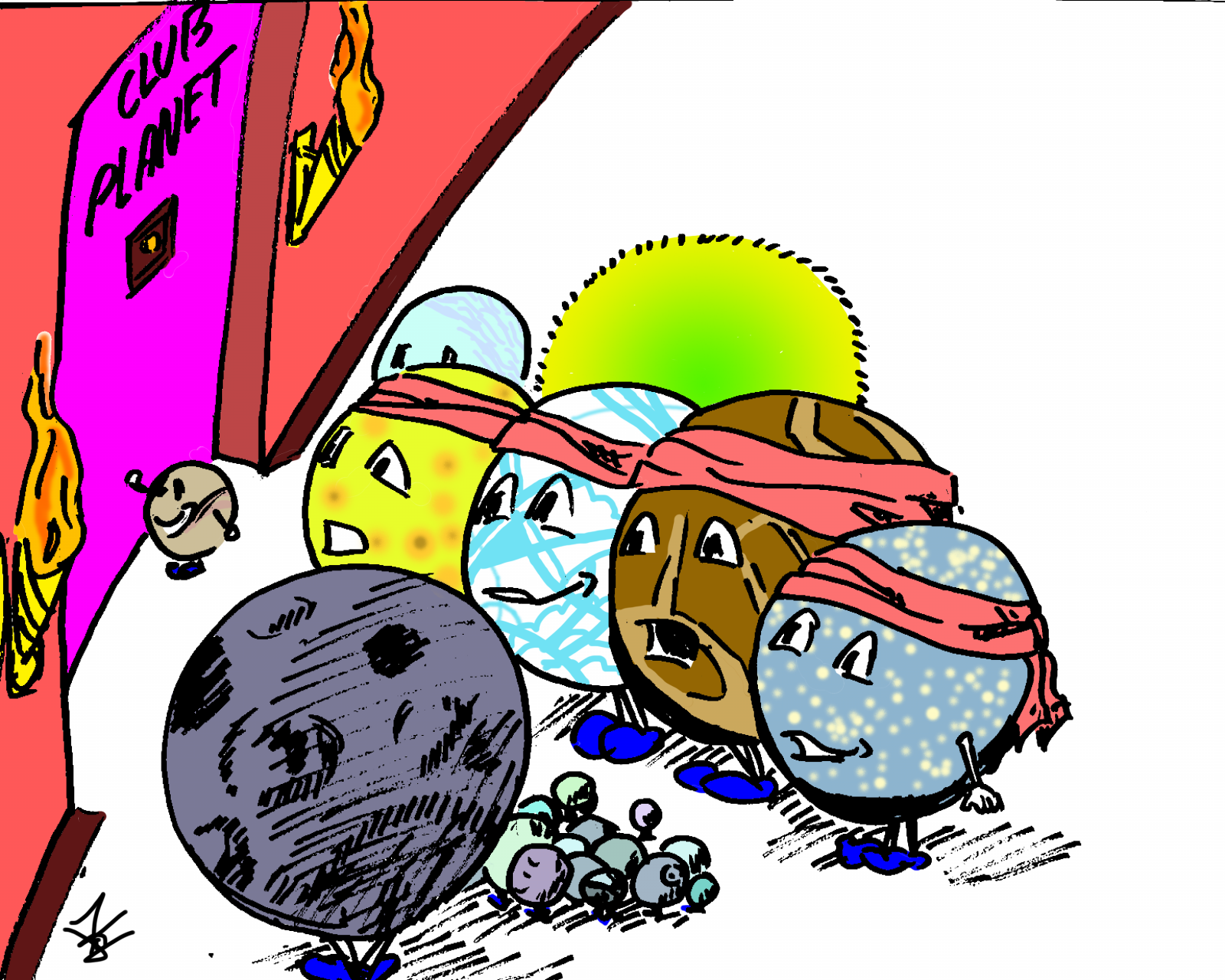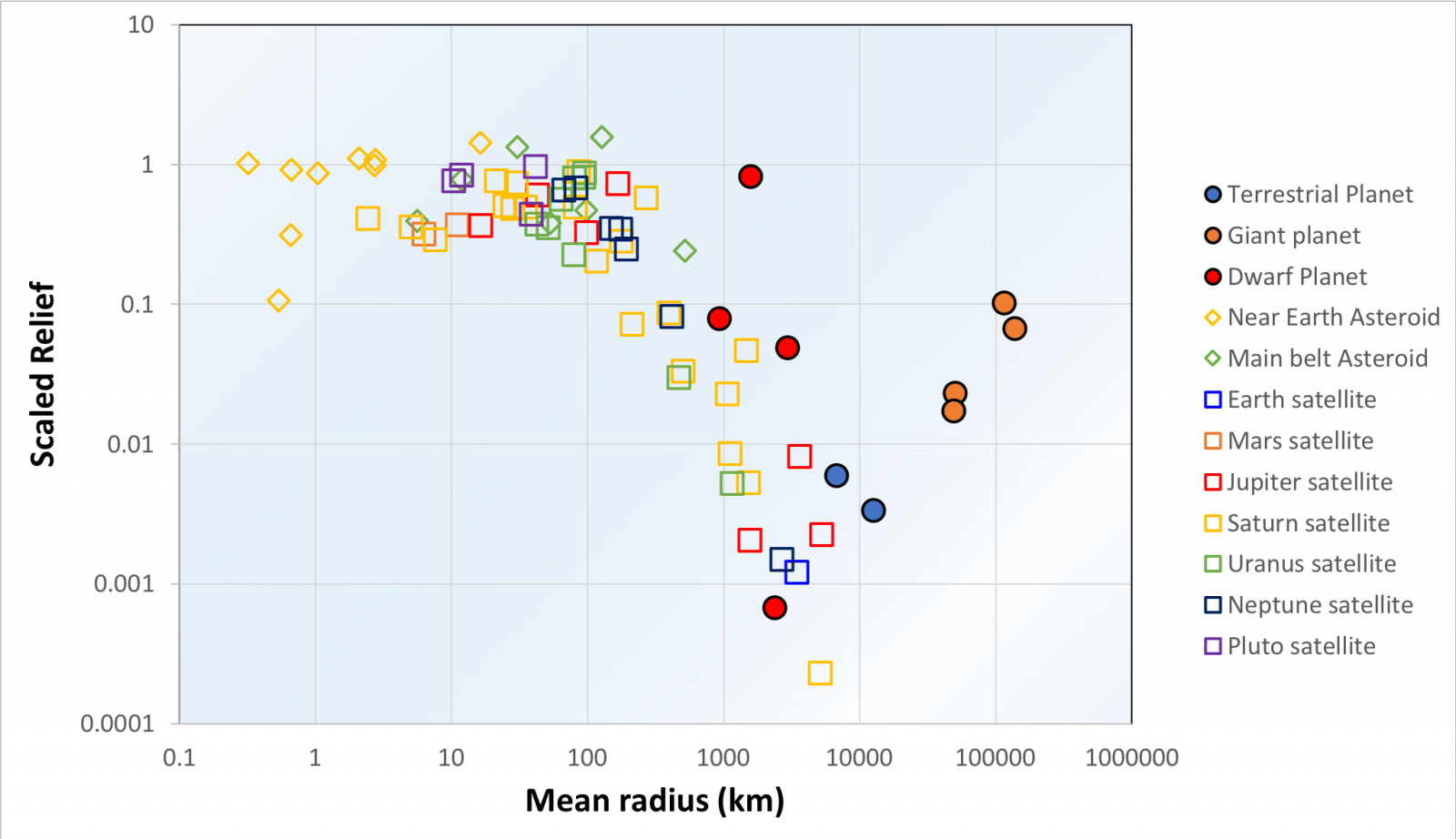
Apart from our own planet Earth, there are a lot of Peculiar Planets out there! In this series we take a look at a planetary body or system worthy of our geodynamic attention, and this week we move back to our own solar system. Many of us will clearly remember the downgrading of Pluto as a planet nearly 12 years ago to the month. In this informative and witty post, Laurent Montesi from the University of Maryland makes a case for reinstating Pluto of planetary status, plus a handful of others, or at least a review of definitions. Bring on Club Planet!

Laurent Montesi
A planet is a celestial body that (a) is in orbit around the Sun, (b) has sufficient mass for its self-gravity to overcome rigid body forces so that it assumes a hydrostatic equilibrium (nearly round) shape, and (c) has cleared the neighbourhood around its orbit. When Resolution 5A was passed by the International Astronomical Union (IAU) during the closing ceremony of its 2006 General Assembly, Pluto was “demoted” from the rank of the true planets to a dwarf planet. Children’s eyes filled with tears over the injustice made to “poor little Pluto”, textbooks were rewritten, and the Nine Pizzas that My Very Excellent Mother Just Served Us turned to Noodles.
I don’t really care.
I see where the IAU came from when crafting this definition, and to some extent, I agree with it. But it is not relevant to me. The thing is, I am not an astronomer. I recognize the authority of the IAU to name geological features on planets and other worlds, but I’m a geologist. Pluto, like many other solar system objects, has too much exciting geology to be ignored!

Figure 1: The five Dwarf Planets currently recognized by the IAU, proud members of Club Planet.
To me, a dwarf planet is first and foremost a planet, and what interests me in planets is their geological activity. If, as stated in part b of the IAU definition, an object is able to “overcome rigid body forces” (whatever that means), that should leave a geological trace. I don’t care if the planet cleared its neighbourhood or not.
So, I take the IAU definition as an invitation for Ceres, Pluto, Eris, Haumea, and Makemake to join the exclusive Club Planet (Figure 1). They all bring interesting geology to the Club. Look at the results of the Dawn and New Horizons missions! Ceres has mountains, fractures, oddly hexagonal craters, and a remarkable bright spot beckoning explorers to study its water-rich interior. Pluto has become a superstar of planetary exploration, with oceans of frozen nitrogen, diverse terrains, large rifts, perhaps a giant ice volcano, and the cutest heart tattoo in the solar system.
I’d like to go even further and open the door of the Club to many satellites (Figure 2). Our Moon is the doorway towards understanding the early evolution of terrestrial planets like the Earth. It taught us about giant impacts and magma oceans. If you want to find liquid water (and possibly life) today, go to Europa or Enceladus. If you are looking for alien plate tectonics, check out Ganymede and Europa. Are you searching for a thick atmosphere, rivers, and lakes? Welcome to Titan. Who has the most volcanic activity today? Please stand up, Io. What incredible rifts you have, Miranda and Charon! From a geological standpoint, satellites are as rich as any planet.

Figure 2: Knocking at the door of Club Planet are several of the satellites of the solar system: Earth’s Moon, the four Galilean Satellites Io, Europa, Ganymede, and Callisto, the large moons Titan and Triton, as well as numerous smaller, but geologically interesting satellites. They are led by Pluto’s moon Charon.
So, what actually is a planet? To the ancient Greeks, they were dots of light wandering against the rigid background of the night sky. These dots then turned out to be balls. Galileo saw four satellites around Jupiter, and in the redesigned solar system, planets could only orbit the Sun. Eventually, so many objects were found that it was decided that it mattered whether a planet “cleared their planetary neighbourhood” or not. Some objects were not enough of a bully to be regarded as a full planet, so they were called dwarfs. All along, astronomy guided our thinking about what is a planet and what is not.
Interestingly, the 2006 IAU definition merges astronomy and geophysics: what does it matter to an astronomer that the object has reached hydrostatic equilibrium? That is a geophysical criterion. Perhaps it matters in the sense that the interior is fluid enough that one should consider how dissipation influences orbital evolution. If that is the case, though, can tidal interaction with satellites be regarded separately?
I don’t know why the IAU was interested in hydrostatic equilibrium, or even if that is a valid question to consider, because, once again, I am not an astronomer. I’m a geologist. I study the geological activity and the interior evolution of… well… planets… and dwarf planets… and satellites… perhaps exoplanets one day… although not the ice giants and gas giants because, as far as I am concerned, they are different beasts altogether.
The fact is, the IAU definition does not help me. Perhaps there could be a geological definition of a planet, or whatever you want to call the various objects I am interested in. Perhaps the International Union of Geodesy and Geophysics (IUGG) — which, like the IAU, is a member of the International Science Council — could propose a definition more in line with my research interests, but as far as I know, there is no discussion of that.
In the meantime, resistance to the IAU definition is growing in our community. David Grinspoon and Alan Stern recently published a Perspective in The Washington Post1. Around twenty scientists got together to discuss a “Geophysical Planet Definition” at the start of the 2018 Lunar and Planetary Conference. One major point of agreement was that no one should feel obligated to follow the IAU’s definition (we are all rebels now), or any other definition.
At the 2017 Lunar and Planetary Conference, Kirby Runyon and coworkers proposed the following “Geophysical Planet Definition”2: A planet is a sub-stellar mass body that has never undergone nuclear fusion and that has sufficient self-gravitation to assume a spheroidal shape adequately described by a triaxial ellipsoid regardless of its orbital parameters. I find there is a lot to like with this proposal. For example, it would allow me to consider satellites as planets. If I focus on internal evolution, it doesn’t really matter what object my planet is orbiting. Of course, this influences the possibility of tidal heating, but I can regard that as an external energy flux, like the energy of accretion for impacts.
Interestingly, the draft “Geophysical Planet Definition” does not explicitly mention hydrostatic equilibrium. In the IAU definition, the hydrostatic equilibrium criterion implies that planets have a minimum size. It also assumes that the planet behaves as a fluid. In that case, what are we to do with the solid planets, like the Earth? We have evidence of frozen hydrostatic bulges, especially for the Moon. In other words, geological bodies can be strong enough to support a significant deviation from hydrostatic equilibrium. Hydrostatic equilibrium is not the best way to define a planet from a geological standpoint.

Figure 3: Ratio of relief scaled by planetary radius against mean radius based on best fitting triaxial ellipsoid for a variety of solar system objects, drawn following Melosh (2011). The maximum relief is controlled by friction for objects smaller than ~100 km in diameter and by strength for larger objects. Note that some objects like Mercury and Venus do not appear on this graph as they have no measurable flattening, due to their small rotation rate. Gas and ice giants appear to deviate from the trend of solid planets.
Where the IAU definition focuses on the driving force, it may instead be useful to focus on the strength of the planet. In his Planetary Surface Processes book, Jay Melosh discusses the relation between strength and gravity3. He concludes that for small bodies, relief (quantified as the difference between the maximum and minimum radius of an object, divided by the average radius) is independent of size, whereas it decreases inversely with the square of the average radius for larger solar system objects. In these larger objects, relief is limited by the strength of the body. The transition between these two trends is a planetary diameter of 200 to 400 km (Figure 3). This division leaves all of the objects for which we have evidence of geological activity driven by internal processes safely within the category of planets. Ancient planetesimals were probably big enough to be regarded as planets, and indeed, evidence for internal differentiation suggests that their interior was quite active.
So, in my view, a planet is simply a body large enough to have small relief as compared to its radius. This is evidence of relatively low internal strength, which allows geological activity to take place. I don’t need to consider where it orbits, and if it cleared its “planetary neighbourhood” or not, as that doesn’t affect geology. The pitfall of my very inclusive view of what is a planet is the consequentially large number of objects to consider, but variety is the spice of life. Why limit the diversity of geological activity to consider?
There can be subcategories, as Alan Stern actually advocated: gas giants, ice giants, terrestrial planets, dwarf planets, satellite planets, even exoplanets. From a geological standpoint, the ones I am least likely to study are actually the giant planets, whose activity is dominated by atmospheric processes. But feel free to consider them.
Perhaps I should leave the term “planets” to the astronomers, and advocate instead for a new term, “geological worlds”. What remains is, whichever classification you choose to adopt should be adapted to the research you do. For me, I want to embrace the geological diversity of our solar system.
Further reading: David Grinspoon and Alan Stern (2018), Yes, Pluto is planet, Speaking of Science – Perspective, Washington Post, May 7 Runyon, K.D., S.A. Stern, T.R. Lauer, W. Grundy, M.E. Summers, and K.N. Singer (2017), A Geophysical Planet Definition, Lunar and Planetary Science XLVIII, Abstract 1448 Jay Melosh (2011) Planetary Surface Processes, Chapter 3, ISBN 9780511977848





Dan W.
Planets have been defined for a very, very long time as bodies which orbit a star, not another non-star (e.g. moons). More recent attempts to change this definition have merely refined that, adding qualifiers like “dwarf”, “gas”, “ice”, etc., but not changing the fundamental property of what it orbits. Similarly, “moon” has been used for a very, very long time to describe bodies which orbit a planet (though I would like to complain here about Earth’s moon being called the generic word “Moon” in English rather than having a proper name like the Latin “Luna”).
Maybe what you need is a different term altogether to describe what you’re interested in, which seems to be “celestial bodies large enough to have hydrostatic equilibrium and interesting geology while still being rocky, rather than mostly composed of gas with a completely inaccessible core”.
Laurel E. Kornfeld
Spherical moons have been considered secondary or satellite planets by some in the scientific community for over 150 years. Many have the same intrinsic properties and processes as the primary planets; the only difference is they orbit another planet instead of orbiting the Sun directly. Then there are rogue planets, which don’t orbit any star. Obviously, they can’t clear their orbits if they don’t have any!
Science is not done by decree of “authority.”The IAU may be recognized as having the right to name objects, but this is very different from defining objects. It is why more than 300 professional planetary scientists immediately signed a formal petition rejecting the IAU definition after it was adopted in 2006 by four percent of the IAU, most of whom were not planetary scientists but other types of astronomers.
Some other good resources on this issue are David Weintraub’s book”Is Pluto A Planet?” Alan Boyle’s book “The Case for Pluto,” and my Pluto Blog at http://laurelsplutoblog.blogspot.com .
Laurent Montesi
Hi Dan, I would be OK with a different word for the geological objects I am interested in. See the final paragraph of the blog entry. Do you have a naming suggestion?
Laurel E. Kornfeld
Spherical moons have been considered secondary or satellite planets by some in the scientific community for over 150 years. Many have the same intrinsic properties and processes as the primary planets; the only difference is they orbit another planet instead of orbiting the Sun directly. Then there are rogue planets, which don’t orbit any star. Obviously, they can’t clear their orbits if they don’t have any!
Science is not done by decree of “authority.”The IAU may be recognized as having the right to name objects, but this is very different from defining objects. It is why more than 300 professional planetary scientists immediately signed a formal petition rejecting the IAU definition after it was adopted in 2006 by four percent of the IAU, most of whom were not planetary scientists but other types of astronomers.
Some other good resources on this issue are David Weintraub’s book”Is Pluto A Planet?” Alan Boyle’s book “The Case for Pluto,” and my blog, known as “Laurel’s Pluto Blog.”
Laurent Montesi
Thanks for the additional resources. I agree to some extent that science is not done by decree of authority (although you have to be careful, some people take that as a reason for everyone, regardless of how carefully they have studied a topic, to chime in). However, news outlets often, and most people, search for that authority, and they found it in the IAU statement. Otherwise, why would that statement lead to a redefinition of the solar system?
Laurel E. Kornfeld
Oops, I apologize for the double posting! The IAU statement should never have led to a redefinition of the solar system. The problem is that the media outlets did not do their homework. If they had, they would have realized that the definition was adopted by a tiny group composed mostly of astronomers who did not study planets, and they would have acknowledged the petition rejecting it by 300 plus professional astronomers. Genuinely accurate reporting would have presented the issue as an ongoing debate with two legitimate sides along with reporting of the very important question of who gets to decide issues like this one.
Many amateur astronomers and writers, including me, have chimed in actively on this debate, but most of us have taken the time and made the effort to study this issue, its history, and the scientific arguments on both sides. I went back to school at Swinburne University’s Astronomy Online program to gain a background in astronomy and planetary science so I could have a voice in this debate.